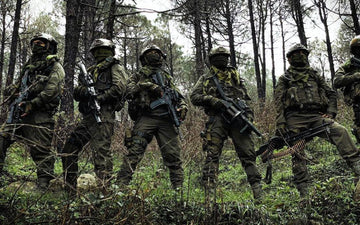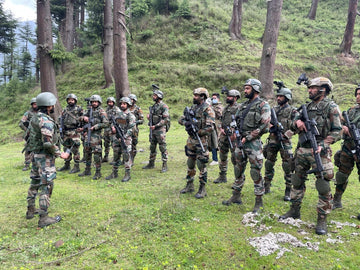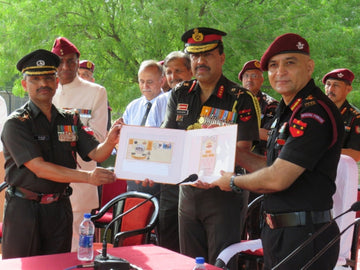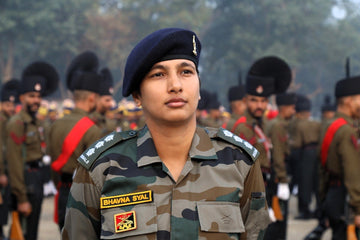Articles
OTA Chennai vs IMA Dehradun - Which is Best for You?
by Olive Squad
on
Jun 19, 2025
When considering a career in the Indian Army, two prominent pathways are the Officers Training Academy (OTA) in Chennai and the Indian Military Academy (IMA) in Dehradun. Both institutions provide rigorous training and development for prospective officers, yet they cater to different career aspirations. Understanding their distinct features is essential for anyone looking to make an informed choice about their future in military service. The differences encompass various aspects including location, type of commission, training duration, intensity, and more. This article aims to explore these factors in detail, offering insights that can help potential candidates make the best choice for their career aspirations.
Historical Context
The history of military training in India is rich and significant, with both the OTA and IMA playing crucial roles in shaping the officer cadre of the Indian Army. The IMA was established in 1932, aiming to provide systematic training for officers destined for the Regular Army. Its long-standing legacy is marked by tradition and discipline, standing as a symbol of prestige and excellence in military education.
In contrast, the OTA was established later, in 1963, with the primary purpose of training officers for the Short Service Commission. OTA opened its Gaya branch as part of its expansion to accommodate the growing number of candidates interested in serving on a shorter commission basis. This diversification reflects a shift in societal attitudes towards military service, accommodating varying career expectations and goals among youth.
Location and Establishment
OTA:
-
Geographic Advantage: Located in Chennai, with a branch in Gaya, OTA enjoys a coastal climate that aids physical training and promotes a vibrant lifestyle.
-
Cultural Richness: Chennai is a hub of cultural traditions, which contributes to a well-rounded experience for cadets during their training. The Gaya branch adds geographical diversity, allowing officers to experience various environmental conditions.
IMA:
-
Scenic Setting: Situated in Dehradun, at the foothills of the majestic Himalayas, IMA boasts a serene environment that is often described as conducive to discipline and focus.
-
Tradition of Excellence: With a longer establishment history, IMA is deeply rooted in military tradition, offering mentorship and structured training to aspiring officers.
Type of Commission
OTA:
-
Short Service Commission (SSC): The training at OTA primarily leads to a Commission with a tenure of about 10 to 14 years. This option is ideal for candidates desiring flexibility to transition into civilian roles or those uncertain about a long-term military career.
IMA:
-
Permanent Commission (PC): IMA prepares officers for careers that can last up to 30 years or more, providing the possibility for extensive professional growth and advancement within the military ranks. This path is better suited for those committed to a long career in the armed forces.
Training Duration and Intensity
OTA:
-
Duration: The training at OTA lasts approximately 49 weeks, focusing on developing essential leadership skills and physical fitness in a relatively short time frame.
-
Intensity: The program is rigorous but practical, preparing cadets to adapt quickly to the demands of military service while instilling confidence and competence.
IMA:
-
Duration: Candidates at IMA undergo training for 1.5 years (18 months) for Short Service Commission entrants, with an option for a comprehensive four-year training program for those in the Regular Course.
-
Intensity: The program is extensive, providing exhaustive training that covers various aspects of military life such as leadership, physical conditioning, tactical knowledge, and academic proficiency.
Training Environment and Focus
OTA:
-
Practical Approach: OTA's focus on a rapid and practical training approach equips officers with skills that are immediately applicable in the field. The cultural diversity of Chennai and Gaya enriches cadets' experiences, preparing them for various challenges.
IMA:
-
Comprehensive Training: IMA provides a more structured and comprehensive training curriculum. The peaceful, snow-capped surroundings of Dehradun create an environment conducive to deep focus and long-term growth.
Gender Eligibility
OTA:
-
Inclusive Training: OTA is progressive in gender inclusivity and trains both male and female cadets, catering to the evolving landscape of military service in India.
IMA:
-
Tradition and Gender: Traditionally, IMA has had a male-only training environment, although discussions are ongoing regarding future inclusivity as social norms evolve.
Career Flexibility and Trends
OTA:
-
Short-term Flexibility: With the increasing trend among youth towards Short Service Commission, OTA has seen a 30% increase in applications in the last five years. This reflects a growing preference for flexible career pathways that allow individuals to explore civilian roles post-service.
IMA:
-
Structured Career Path: The Permanent Commission route taken by IMA graduates permits a structured career with multiple avenues for promotions and specialized training courses. This is particularly appealing to those focused on a long-term commitment to the Indian Army.
Statistical Data and Research Insights
According to data from the Ministry of Defence, there is a significant shift in career preferences among younger generations. The growing inclination towards Short Service Commissions, offered by OTA, stems from evolving career aspirations, which prefer flexibility and the possibility of transitioning into civilian life.
Research indicates that OTA officers positively contribute to their units' operational efficiency thanks to their adaptability and fresh perspectives gained from diverse training environments. This contrasts with IMA, where the longer duration of service can often lead to deeper specialization and expertise in military operations.
Comparative Analysis
Choosing between OTA and IMA ultimately comes down to individual career aspirations and lifestyle preferences. Here’s a brief comparison:
| Criteria |
OTA (Chennai) |
IMA (Dehradun) |
| Location |
Coastal, culturally vibrant Chennai |
Serene, disciplined Dehradun |
| Type of Commission |
Short Service (10-14 years) |
Permanent Commission (30 years+) |
| Training Duration |
49 weeks |
1.5 years to 4 years |
| Gender Eligibility |
Male and Female |
Currently Male only |
| Career Flexibility |
High (transition to civilian roles) |
Structured path for long-term military |
| Trends in Applications |
30% increase towards Short Service |
Traditional appeal for Permanent Service |
Challenges and Solutions
Challenges:
-
Decision Paralysis: Aspirants may feel overwhelmed by the choice between OTA and IMA, given the significant implications of their decision.
-
Public Perception: There could be societal pressures and perceptions associated with choosing shorter service commitments, leading some to undervalue OTA.
Solutions:
-
Informed Decision Making: Aspirants are encouraged to research extensively, consider their career aspirations critically, and seek mentorship from alumni of both academies.
-
Awareness Campaigns: Military authorities can promote the benefits and career flexibility provided by the OTA, thereby elevating its status among aspirants.
Future Trends and Predictions
The landscape of military recruitment is gradually evolving, with several trends likely to shape the future of OTA and IMA:
-
Increased Inclusivity: With growing societal shifts, it is anticipated that both institutions may enhance gender inclusivity, allowing women to join IMA in the near future.
-
Focus on Technological Integration: As military operations become increasingly technology-driven, both OTA and IMA may integrate more technological training into their curricula, preparing officers for modern warfare.
-
Altered Career Dynamics: With the realization that many young professionals desire versatile career options, more programs like those at OTA may emerge to cater to this demographic, balancing military and civilian career paths.
Conclusion
Deciding between the OTA in Chennai and the IMA in Dehradun is a significant choice that will shape your career in the Indian Army. The decision hinges on personal preferences regarding commission type, training duration, lifestyle aspirations, and long-term career goals.
Should you seek a shorter tenure with flexibility for future endeavors, OTA may be the path for you. Conversely, if you are committed to a career filled with comprehensive training and opportunities for advancement, then IMA could be the perfect fit. Whatever your choice, pursuing a career in the Indian Army is a commendable and noble endeavor that promises both challenge and reward.
Take the time to reflect on your aspirations and engage with current cadets or alumni to gather insights that can guide your decision-making process. The road ahead is significant, and continuous personal development and commitment to excellence will serve you well in your chosen path.





